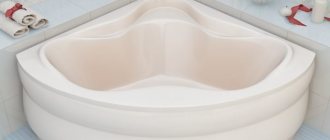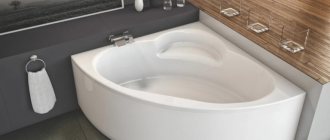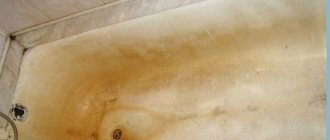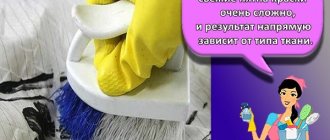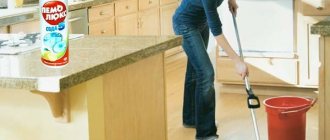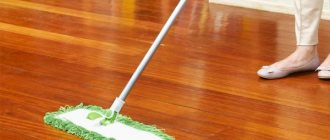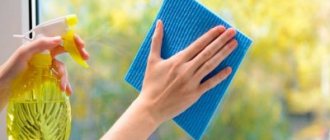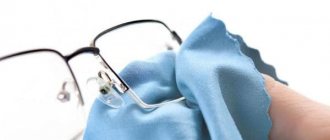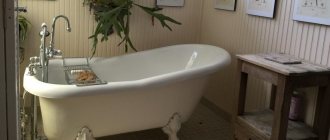A snow-white, shining bathtub invariably reveals a good housewife who pays close attention to all the details of the house. But, before washing an acrylic bathtub, you should carefully study the recommendations of specialists. Indeed, sometimes, active cleaning of this plumbing equipment with inappropriate means causes the appearance of yellowness and grayness.
The bath should be cleaned daily using a small amount of detergent or available products. It should be noted that some homemade recipes (for example, soda or citric acid) are not suitable for cleaning plastic from dirt and limescale.
Photo: bath before and after cleaning
To choose the right recipes, you need to study customer reviews and advice from professionals. To do this, we have collected the most common recommendations together.
Detergent overview
Specialized cleaning products are available for bathtubs with acrylic coating. They help to quickly get rid of rust, plaque and wash the liner after swimming with colored foams.
Good reviews about the spray and gel from RAVAK Cleaner. These are products that are manufactured by a well-known manufacturer of acrylic bathtubs. It contains mild cleaning components that work well on the most common stains. In particular, Ravak will help wash rust from the bottom of the bathtub, remove grease and soap residues from the walls and restore shine and whiteness to acrylic.
Ravak for hot tubs
Bass is another well-known acrylic bathtub cleaner. This product comes in the form of a gel, unlike Ravak, it cleanses not only of dirt, but also of germs. It contains weakly concentrated acids. The product is applied to problem areas of the bath, distributed evenly over them, and then washed off with water. To remove it, you need to wipe the liner with the hard side of the sponge.
Cif acrylic bath cream has a pleasant smell and cleans plastic well of soap residues. But it will not help with pronounced yellowness or rust. It is considered more of a preventative than an active cleanser.
Cif Strength Cream for acrylic bathtub
The most common cleaners include Domestos and Sanox. In general, these funds are suitable, but we will tell you more about each below.
Review of professional household chemicals
For regular cleaning of the bathtub, it is recommended to use detergents that are safe for acrylic surfaces. Some of them are especially effective and can be used to remove even old stains.
"Akrilan"
The spray is easy to apply. The resulting foam is distributed over the surface and left for 5-10 minutes. After this, the bath is thoroughly rubbed with a sponge and rinsed with water.
"Akrilan" removes stubborn dirt, lime deposits, rust, mold and mildew.
The product effectively removes rust stains and old limescale deposits. After using it, it is not necessary to use polish, because... A thin dirt-repellent layer remains on the bathtub. In addition, it is capable of destroying most types of microorganisms.
Cif
The product is available in the form of a spray and cream. The first option is more convenient, because The spray bottle allows you to quickly spray the bath.
Cif does not contain abrasives or aggressive substances, but it effectively removes most types of contaminants from acrylic bathtubs.
The product in the form of a cream is first applied to a sponge and then evenly distributed over the moistened surface. After about 3-5 minutes, the bath is rubbed again. At the end of the treatment, the remaining cleaning composition is washed off.
This product is suitable for daily use because... does not react with acrylic and does not damage the coating. Cif is not effective against mold.
Unicum
It comes in spray form. They treat the bath and leave the composition for 15-20 seconds. After this, the walls are thoroughly wiped with a sponge and washed off with water along with the dirt. If necessary, repeat the procedure. After using this product, a protective film remains on the surface.
Unicum spray is a highly effective product for cleaning and renewing acrylic bathtubs.
Bon Professional
This is a solution designed for cleaning plastic, but it can also be used to remove dirt from acrylic. The container with the product is equipped with a spray bottle to facilitate application.
The cleaning composition is left on the surface for 3-5 minutes. After this, the bath is thoroughly wiped with a sponge. Then the product and dirt are washed off with warm water. Bon Professional creates a thin film on the coating that prevents rapid re-contamination.
"Mr. Cheester"
It is produced in the form of a spray. The product is suitable for washing not only acrylic bathtubs, but also metal and plastic surfaces.
The solution is sprayed over the coating and wait 10 minutes. Then the bath is thoroughly wiped with a sponge. The remaining product is washed off with plenty of water.
“Mr. Clean” contains a special polymer additive, so after its use a thin film remains on the surface, protecting the bath from the effects of chlorine and other contaminants.
"Cinderella"
This is a budget product, the price of which is no more than 100 rubles. It comes in gel form. It is applied to the surface for 5 minutes and then rinsed off thoroughly. Before cleaning the bathtub, you need to wear gloves and a respirator, because... The product has an extremely unpleasant odor and can cause an allergic reaction if it comes into contact with the skin.
The Cinderella product does not contain abrasive particles and has a soft, creamy consistency.
Folk remedies for cleaning
Unlike enamel, acrylic perfectly withstands the effects of acids. Therefore, the easiest way to clean a bathtub is to buy a solution of citric acid and dilute it with water. The ratio should be minimally concentrated. For example, for 50 liters of water take 1500 ml of 7% acid. It is important to note that only citric acid solution is allowed to be used (powder will not work).
Another option for whitening an acrylic bathtub is to wipe it with pure lemon juice. Of course, this method is not cheap, but its effectiveness has already been tested by many housewives. A fresh lemon is cut in half, after which the gray areas are rubbed with the juicy side. The juice must be left on the plastic for at least 8 hours. Afterwards, simply rinse with water. This is the only safest way to rinse a bathtub before bathing a child.
Vinegar works great for removing limescale and yellowing. It is best to use either acetic acid or a 9% apple solution. The proportions are similar to citric acid - for a full bath you need to take 1500 ml of acid and dissolve it in water. The liquid must be left for 10 hours, then rinsed off, wiped the walls with a fleecy cloth and spilled with water again.
Even regular bleach can help restore the shine to your bathroom. It is important to remember that it is strictly forbidden to use products that contain chlorine. Therefore, it is better to take a product for colored fabrics or wool. The stain remover is evenly distributed over the bottom and walls of the bathtub, and then left for several hours. The minimum is 4 hours, the maximum is 8, but more is not recommended. After time has passed, the bath is washed with plenty of water and wiped with a sponge.
The most difficult thing to clean at home is an acrylic whirlpool bathtub. The main problem that its owners face is that the injectors become contaminated with soap deposits and salt deposits. To get rid of this, you need to pour a weak chlorine solution into the hydromassage system. In order to completely clean the system, 20 liters will be enough. The liquid must go through several cycles through all nozzles, after which it must be drained.
What should not be used to clean a dirty acrylic bathtub:
- Acetone. This is strictly prohibited, as it corrodes the plastic. The consequences of such cleaning can be not just stains without paint, but real holes in the liner;
- Petrol. Just like acetone, this substance has a very negative effect on acrylic and the paints with which it is coated. After such washing, unsightly gray spots and stains remain;
- Soda and other powders. By itself, baking soda is an excellent bleach, but it is too abrasive. Due to active washing with powders, scratches appear on the glossy surface of acrylic, which after a while can become cracks.
In addition to the choice of product, the method by which the bath is cleaned plays an important role.
How not to wash an acrylic bathtub:
- Never use hard brushes made of artificial bristles or metal brushes. They scratch acrylic mercilessly, causing small scratches to form on its surface. It is best to use a special sponge. It differs from a regular laundry sponge in pore size and material;
- Do not mix multiple detergents during washing and rinsing. Some of them contain dangerous components that, when reacting with substances from other products, form a poisonous gas. In particular, Domestos is known for this effect, which, when mixed with other cleaning gels, produces chlorine gas;
- Do not wash off chemical cleaning products with hot water. Also due to the likelihood of the formation of toxic fumes.
Cleaning the bathtub is carried out only with gloves
What is the acrylic surface afraid of?
Powders, creams and pastes, which we are used to using to tidy up cast iron and steel bathtubs, should not be used at all. The fact is that many of their components, which are safe for enamel, are considered too aggressive for acrylic.
At best, they will erase the shiny coating and leave scratches; at worst, they will completely destroy the structure of the material.
Acrylic bathtubs do not belong to the group of expensive products; more often they are products of the middle segment (except for elite models). For example, the BAS Fantasy model with hydromassage costs about 30 thousand rubles. – a budget option for a family with average income
For example, all-purpose cleaning powders and pastes often contain fine abrasives. The smallest solid particles do not leave marks on the enamel coating, but can ruin acrylic, which is sensitive to mechanical damage. Therefore, such universal products for the kitchen and bathroom as “Komet”, “Domestos”, “Silit” (powder) are prohibited.
In addition to abrasives, cleaning products should not contain the following ingredients:
- chlorine;
- formaldehyde;
- acetone;
- ammonia;
- oxalic acid.
Chlorine corrodes the material, making it porous and unsightly. Acetone, ammonia and some solvents destroy the shine of the coating, gradually destroying the top layer. Acids and formaldehydes are also incompatible with acrylic.
Relatively soft acrylic is afraid of hard and sharp objects. Please note that even such a sanitary measure as washing pets is dangerous for him, as their sharp claws can easily damage the coating. For such hygiene procedures, it is recommended to use a plastic basin or a specially installed tray with a separate shower.
If the damage to the bathtub turns out to be catastrophic, it can only be saved by restoration with liquid acrylic, which is carried out using special technology by professional plumbers
If you hand wash or clean bulky items in the bathtub, use a rubber mat. It will protect the bottom and walls of the container from damage that can be caused by metal buttons, fasteners or zippers. The same rug is an excellent stand for a plastic basin, which can also scratch acrylic.
Another threat to acrylic bathtubs is very hot water. It does not affect as clearly as sharp objects, but over time it destroys the top layer, making it more porous and weaker. As a result, all the negative contents of tap water - lime, rust, dirt - are absorbed into the acrylic and make the surface of the bathroom unattractive.
To ensure that the water contains fewer foreign impurities that negatively affect acrylic, fine filters are installed on the supply pipes. In the event of a water supply accident, they trap particles of clay, sand, and contaminants.
Now let's look at effective products for acrylic bathtubs, which are ideal for adding shine, removing scratches and regular maintenance.
How to clean an acrylic bathtub from yellowness
Yellowness is the most common problem faced by owners of acrylic bathtubs. The surface of the plastic turns yellow for several reasons:
- Incorrect care. In particular, the use of inappropriate means for cleaning the walls, treatment with powdery products;
- Bath age. Naturally, over time, the white color of the bath becomes more beige or yellow. This can only be combated by bleaching the liner;
- High water hardness. Chlorinated or saturated with other salts liquid has a negative effect on plastic. To solve this problem, you need to add a small amount of special water softening agents to the water.
Age-related yellowing of the bathtub
To get rid of yellowness, you need to choose a suitable cleaning agent and distribute it evenly over the entire surface of the container. If the bathtub is not darkened over the entire surface, but there are individual yellow spots, then under no circumstances use abrasive products on them. It is better to apply the bleach in several layers.
How to whiten a bathtub:
- Lemon, lemon juice, citric acid. This is a natural bleach that effectively copes with the natural causes of yellowing: dirt, plaque or soap residue;
- Vinegar and its derivatives. Pure vinegar cannot be used, but its solutions are not only possible, but also necessary. It will not only whiten the surface of the plastic, but will also destroy the majority of pathogenic microorganisms;
- Professional bleaches for acrylic. These are Sanox, Cersanite, SanElite;
- Dishwashing detergents also work well to bleach. In particular, good reviews about Fairy.
Recommendations for cleaning depending on the type of contamination: useful recipes
When choosing a cleaning product, take into account the characteristics of the contamination. Certain folk recipes are especially effective for removing old stains.
Limescale
To eliminate it, it is better to use vinegar. First, warm water is drawn into the bath. After this, add 1 liter of vinegar to the liquid. The solution is left for 12 hours. After this, it is drained, the surface is rinsed and thoroughly rubbed with a soft cloth.
It is not recommended to leave the solution in the bathroom for a long time, because... this will lead to an undesirable reaction.
If the plaque is old, it is better to use a product that includes citric acid, vinegar, salt and soda. First, water is taken into the bath and vinegar is poured. Then 50 g of all bulk components are dissolved in the liquid. After 10 hours, the mixture is drained and the surface is thoroughly rinsed. This product not only removes limescale, but also has a whitening effect.
Yellowness
A high content of chlorine and iron impurities leads to yellowing of the surface. To eliminate the defect, use mustard powder with soda. The components are taken in equal proportions and diluted with water to the consistency of thick sour cream. Apply the product to contaminated areas and leave for 30 minutes. Then the mixture is washed off and the surface is dried with a dry towel.
Mustard powder with soda effectively removes yellow deposits from acrylic bathtubs.
Rust
To eliminate it, folk remedies are effective, including hydrogen peroxide, ammonia and lemon juice. The last component has the mildest effect. Small rust stains can be removed with the juice of 1 lemon. They treat contaminated areas and leave the composition for 10 minutes. After this, the surface is wiped with a sponge and rinsed with water. To enhance the effect, dissolve 1 tbsp in juice. soda
The resulting composition is used to treat contaminated areas.
Silicone sealant
Over time, it darkens and becomes moldy. In this case, it needs to be replaced. To remove old sealant, vinegar essence and white spirit are used. Soak a soft cloth with the chosen product and wipe the surface with it. After 7 minutes, it is rinsed with water and treated again with a solvent. The procedure is repeated until the old sealant is completely removed.
Glue
Remains of glue from an acrylic bath can be removed with a solution of citric acid. To prepare the product, mix 30 g of dry powder with 1 liter of water. Then the fabric is soaked and placed on the contaminated area. After 15 minutes, the surface is washed. The softened glue is removed. Then a cloth soaked in a solution of citric acid is applied again. The procedure is repeated until the coating is cleaned.
Primer
To eliminate it, do not use formulations containing alcohol and other aggressive substances. Such contamination can only be removed mechanically. First, the primer is softened with warm water, after which it is carefully scraped off with a blade.
Is it possible to wash an acrylic bathtub with Domestos?
Considering that this is one of the most common and advertised cleaning products in the CIS, this question torments more than one housewife. In general, yes.
Domestos Ultra White for baths and toilets
But, there are a number of rules on how to wash an acrylic bathtub with Domestos and not spoil it:
- Domestos should not be left for long periods of time. It contains such strong acids that they can easily corrode even vitreous enamel, not to mention the dyes that are used for plastic. The maximum exposure time of the product is 10 minutes;
- How to use it: you need to apply a cleaning agent to the upper part of the wall and spread it with a sponge over the entire wall. All work must be done with gloves, otherwise allergies may develop. Afterwards, you need to leave Domestos on the acrylic for up to 10 minutes, wipe with a sponge again and rinse off;
- To consolidate the effect and give the bath shine, it is also treated with a wax-based polish. This is completely harmless; after such cleaning, you and your children can bathe.
Which product is better to choose for cleaning the bathtub: tips for buyers
The best product for acrylic bathtubs is an individual concept. Each housewife puts her own characteristics into it. Therefore, during the selection process, follow the general recommendations:
- choose compositions suitable for the coating of the bowl (this is indicated on the packaging);
- Follow safety rules when cleaning;
- Do regular preventive maintenance and clean with more powerful products once a month.
And don't be afraid to experiment! To find “your” option, you often have to try 2-3 or even more cleaning products.
How to clean an acrylic bathtub video
Is it possible to wash an acrylic bathtub with Sanox?
A more affordable analogue of Domestos is Sanox. It has similar properties, but in addition to disinfecting and cleaning, it also quickly whitens the surface of an acrylic bathtub. The rules for its use are similar to Domestos.
Stork SANOX Gel
The product is evenly distributed over the walls and bottom of the plastic liner, after which it is not washed off for some time. There are several types of Sanox for baths:
- Gel;
- Foam;
- Spray.
The gel and foam are applied with a regular sponge to the entire surface or individual areas of the bath, and the spray is sprayed onto the acrylic at a distance of 10 cm. This will cover the maximum area and avoid increased concentration of the product at one point.
What not to use when cleaning
If you have an acrylic bathtub at home, then you need to know what cleaning product you should not use. The properties of acrylic determine which cleaning agents and cleaning devices can be used when washing an acrylic bathtub.
Acrylic is a liquid metal that becomes solid when interacting with certain chemicals. Acrylic bathtubs require special care, since an incorrectly selected cleaning agent or detergent can cause damage to the structure of the coating.
Before you start cleaning your bathtub, be sure to check the composition of the cleaning product you choose and make sure that it does not contain the following components:
- Formaldehyde
- Chlorine
- Acetone
- Alkali, acids, ammonia
Please note: the chosen product should also not contain even small abrasive particles that can ruin the appearance of the bathtub coating.
How to care for a bathroom after restoration
It is believed that after restoration the bathroom should be looked after extremely carefully, washed exclusively with soap and generally be afraid to breathe on it.
Actually this is not true. The acrylic liner and the “fill-in bath” (coating with liquid acrylic) are no different in care from a new bathtub and, on the contrary, have a number of advantages over factory enamel.
But for bathtubs restored by enameling (painting with a brush or roller), it is true that very careful care is needed. The enamel is only 50 microns (0.5 mm) thick and is sensitive to impacts, the quality of tap water and aggressive detergents.
We have compiled a detailed list of recommendations on how to care for your bathroom depending on the way it was renovated. You will learn how to clean a fill-in bathtub, what products can and cannot be used, what to do in the first week after restoration, and what it is better not to do to ensure that the bathtub lasts a long time.
Why acrylic needs to be cleaned carefully
Wear-resistant acrylic, used in bathroom fittings, is a type of durable and impact-resistant plastic. However, the material can easily be damaged if not properly maintained.
To clean the surface from dirt and all kinds of deposits, do not use hard metal sponges or abrasive powders. The main danger for acrylic is contact with sharp objects, which can damage the integrity of the coating and leave deep scratches. So, below you can find out how to wash an acrylic bathtub and how often you can do it so that the surface is clean and at the same time not damaged.
Important : Do not bathe pets or wash, for example, kitchen utensils in a bathtub made of acrylic fiber. If there is such a need, it would be good to lay a thick rubber mat on the bottom.
